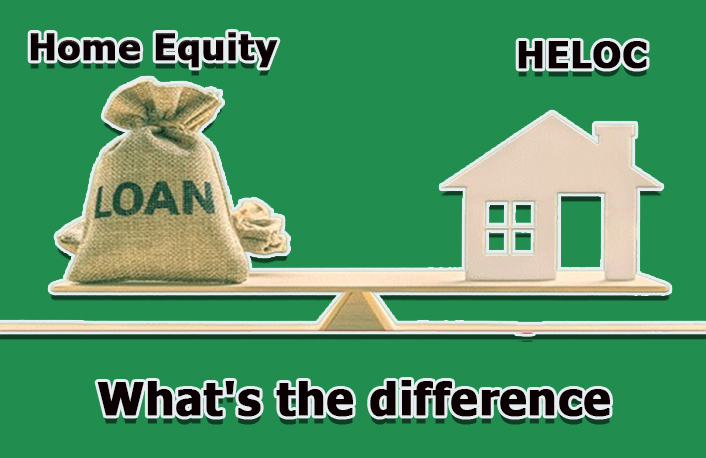If you have a home, you might want to rebuild it or you might need funds for another financial achievement. A cash-out refinance whereby you sell off your old mortgage for a new one and collect cash back could make you hesitant. However, you can get the funds you need by understanding what’s the difference between home equity vs. HELOC.

Understanding what’s the difference between home equity vs. HELOC is that home equity offers you an upfront amount that you repay in fixed payments, while a home equity line of credit (HELOC) enables you to have access to equity as required to a specific amount. Furthermore, this article will discuss more on home equity vs. HELOC based on benefits, drawbacks, and major differences.
What is Home Equity
A home equity loan is a fixed-term loan that is given to a borrower depending on the equity in their home by a bank or another lender. If their application is accepted, borrowers apply for a specific amount and are given it all at once. For the duration of the loan, the interest rate and payment schedule for a home equity loan are fixed.
You must have sufficient equity in your home to be eligible for one of these loans. Lenders use various formulas, including the combined loan-to-value (CLTV) ratio, to calculate this. Generally, you can borrow up to 80% of your equity in the home.
Furthermore, the interest rate on a home equity loan is set for the duration of the loan, just like with a fixed-rate first mortgage. Throughout the loan, the fixed monthly payments are also made in equal installments. Each payment is split between the principal and interest on the loan.
The repayment period lasts between five and thirty years. Also, home equity loans have consistent, dependable monthly payments, regardless of the term, which makes budgeting for them comparatively simple.
Benefits and Drawbacks of Home Equity
For certain borrowers, home equity loans can be the right choice, and they have a few benefits and drawbacks over other loan kinds.
Benefits
- Fixed sum, reducing the chance of too many purchases.
- It’s simpler to budget when payments are fixed each month.
- The interest rate is lower than on a lot of other loans.
Drawbacks
- Unable to borrow more money in case of emergency without taking out a new loan.
- Refinancing is required to receive a lower rate.
- May forfeit your house in the event of default.
What is a Home Equity Line Of Credit (HELOC)
A home equity line of credit (HELOC) is a revolving credit that allows borrowers to take out loans, make payments, and withdraw funds if not used. They are secured by the equity in your house, just like home equity loans. As long as you make the minimum payments due, you are free to use HELOC’s credit line whenever you need to until the end of its term.
The amount of those payments will change according to your current outstanding balance. While fixed-rate HELOCs are occasionally offered, most HELOCs have variable interest rates that fluctuate over time. Your creditworthiness and the amount of money you are requesting will determine the initial rate that the lender may offer you.
It’s crucial to remember that switching from interest-only to full principal and interest payments can be rather abrupt. Therefore, borrowers should plan for those higher monthly payments. Even though HELOCs function similarly to credit cards, you run the risk of foreclosure if you can’t make the payments because your house is used as collateral. In addition, many of the credit cards are unsecured.
Benefits and Drawbacks of Home Equity Line Of Credit (HELOC)
The following are the benefits and drawbacks of a home equity line of credit (HELOC);
Benefits
- Decide how much of your credit line to use, if at all.
- Variable interest rates allow payments and rates to change according to the state of the market.
- The interest rate is lower than that of unsecured loans.
- Emergency credit line available
Drawbacks
- More difficult to budget due to interest rate fluctuations.
- Because variable interest rates fluctuate with the market, payments and rates could increase.
- Might lose your house if you are unable to pay.
- Simple to spend impulsively up to your credit limit.
Home Equity vs. HELOC: What’s the difference
Home equity vs. home equity lines of credit (HELOC ) differ in how loan proceeds are accessed. A home equity loan offers a single lump sum with a set repayment schedule, whereas a home equity line of credit (HELOC) offers a line of credit that can be accessed as needed.
Qualified borrowers are approved for a maximum credit limit and may borrow up to it. Monthly payments are calculated based on the outstanding principal balance and the applicable APR. Additionally, home equity loans have fixed interest rates, while HELOCs have adjustable rates.
Final Thought
Although home equity loans have fixed rates and payments that are predictable and stable, a home equity line of credit (HELOC) offers continuous access to funds as needed. As with any credit product, it’s crucial to avoid taking on more debt than you can manage, particularly if your house is at risk.

